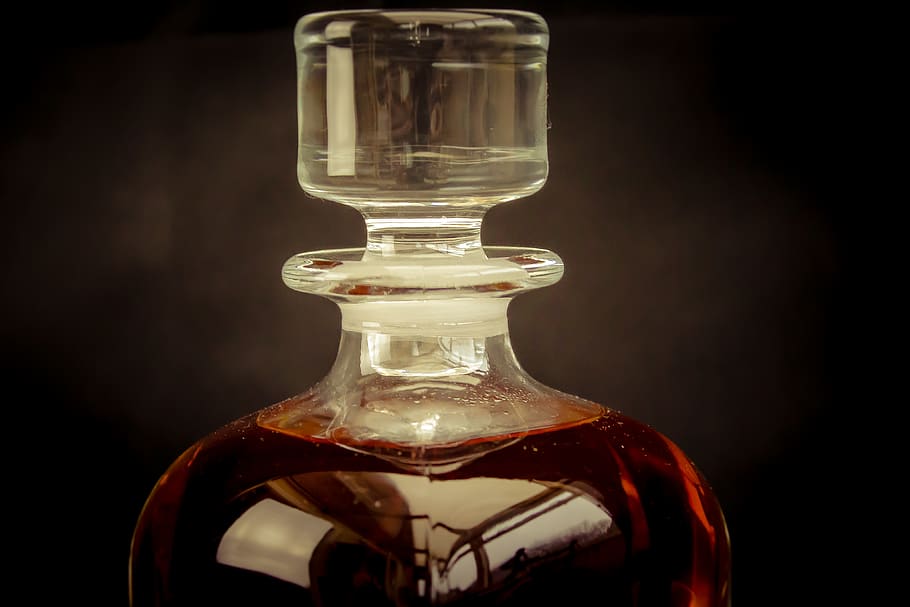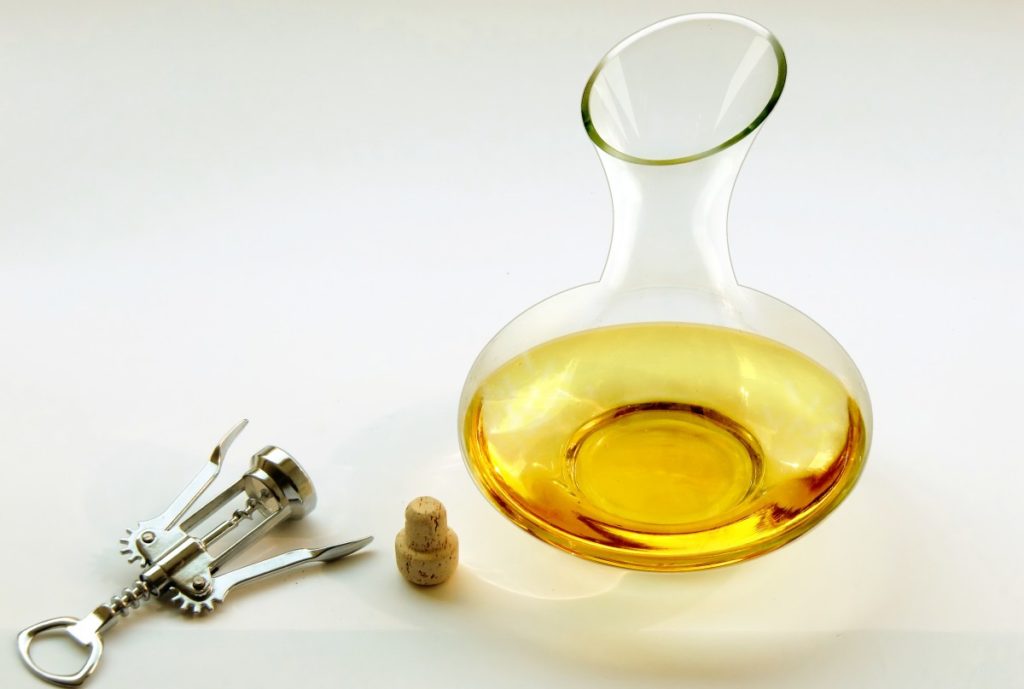Wine has accompanied man throughout history. For the first time, a drink prepared by the fermentation of grapes appeared in ancient Greece after the development of this plant. The resulting liquid immediately liked the rulers and ordinary citizens. There was even a cult, as well as a god - Dionysus. Over time, the relevance of the drink has not been exhausted, on the contrary, thanks to films and literature, wine has acquired a new status.
The editors of the site "bestx.htgetrid.com/en/" have prepared for you a rating of the best decanters for wine for 2020.

Content
Is this device so important?
Wine is a unique drink that has influenced the entire modern culture. True connoisseurs do not just drink it, they carry out a number of actions that reveal the entire taste of the drink.
Wine is stored under certain conditions so that aging will only benefit, and not ruin it. However, drinking from a bottle is not customary, since it is necessary to separate the sediment that forms during the entire storage. To produce this, a special product was invented - a decanter, which is a special jug of various shapes. It is used to drain, saturate and serve wine. Not a single gala evening is complete without it.
The decanter is made of crystal - this is the best material that has been tested over the years. Regardless of the type of wine, it will look unique in this product. In crystal, the product reveals positive properties, which makes them want to enjoy and savor every sip, and not rather drink or pour out, as in the cheap options. There are more budget glass models.
How did the decanter come about?
Surprisingly, such a design appeared almost immediately with wine, that is, in the ancient era. In those days, before serving a product on the table, it was necessarily poured into clay vessels that had a special shape. This was most common in Ancient Greece, and glass versions began to appear in the Roman Empire. For that time, possessing such an item was a luxury, and glass production was not fully established, which is why numerous wars completely brought down production. This material was replaced by new types - porcelain, copper and bronze.
After some time, mass production of glass products began in Venice. In addition to the production of vessels, they were also supplemented and improved with various decorations or unusual combinations of materials. The shape of the wine decanters has also been changed. Most of the craftsmen began to create a decanter - an elongated neck and a wide bottom. Such a product was in great demand among many connoisseurs, and also became the prototype of modern models.
To carry out the transfusion of young wine, this does not require special skills or deep knowledge. Everyone can perform this action, just take a clean decanter, pour a little wine, rinse to eliminate excess odors and drain into a separate vessel.After that, the prepared wine is dramatically poured into a decanter so that the drink is saturated with oxygen. The recommended infusion time is 6-8 hours, so excess carbon dioxide is released, which allows you to completely soften the taste and fully reveal the bouquet.
To transfuse old wines, the sommelier must have some knowledge and take into account every feature of the product. Most often, these wines are stored horizontally. Thanks to this solution, the sediment falls out only on one side, but this is an optional decision and a person can store the product in any position. Before serving the wine, it is necessary to put it vertically, this is done 24 hours before opening, so all the sediment is at the bottom. After completing these processes, the drink is poured into a vessel and it is infused a little.
What to look for when choosing?
If a person truly appreciates wine and is not limited to cheap purchases, but orders products on foreign websites or specialized stores, then he needs to buy a decanter. The product will be a pleasant gift for him. The user may not pay attention to what the product is made of, because regardless of this, the drink will still be enriched with oxygen and create a unique aroma.
In some cases, the product will be a good decoration that complements the overall design of the room. Therefore, when choosing a product for decoration, it is important to look at the abstract features of the form, or, conversely, to give preference to the classic version. This product includes a funnel, stand or drip tray. However, this is done at the request of the user himself.
When a vessel is bought by the owners of restaurants where visitors order expensive varieties, it is important to follow some rules:
- The number of decanters must exceed the total number of tables;
- The dimensions of the vessel are selected according to the wines;
- The appearance of decanters should not stand out from the overall interior;
- And the last thing to remember is that quality comes first.
Is the influence of the decanter exaggerated?
Many spirits who do not understand wine connoisseurs can say that the vessel is a kind of Placebo. There is no practical benefit from the product, it's just a decanter for a bright presentation, the essence of the product will not change from this. Of course, such low awareness and false arguments form a controversy, but more often people suggest trying the difference in tastes, and this is what happens:
- White varieties completely get rid of sulfur dioxide. Therefore, an unusual and pleasant taste is acquired, which is accompanied by the softness and aroma of ripe grapes.
- Red wine is characterized by the presence of fruity tones, and not the excessive viscosity in the mouth, from which many experience discomfort.
- When serving a matured variety, a precipitate falls out, which does not allow to fully reveal the taste.
- High-speed oxidation of younger wines, this allows you to improve the taste indicators at times.
- Some people buy decanters for full disclosure of whiskey or cognac. After all, only in this way the product acquires a rich bouquet and aroma, which allows you to elevate the process of drinking alcohol.
Decanter shape
The maximum capacity of a standard decanter is one liter; there are also products where this value is twice as high. In most restaurants, it is customary to pour a vessel not to the brim, but in 1 liter - 0.75, and in 2 liters - 1.5 liters.

Younger varieties need good oxygenation, the separation of sediment is not so important for them. Due to the fact that the product contains a lot of tannins, for some users, such wines may seem too tart, which will not bring aesthetic pleasure, but rather disappoint. To achieve a good enrichment, it is important to choose the right shape. Experts recommend paying attention to the design with a narrow neck, but a wide bottom, as it promotes rapid oxygen saturation, and the narrow part will retain all the unique aroma.
With mature wines, everything is more difficult, although they are saturated with oxygen during long-term storage, it is important to separate them from the sediment, which gradually accumulates. This substance helps to determine the quality of wine and any connoisseur, seeing it, understands that it is not a fake. However, the sediment tastes unpleasant and can ruin all impressions of the noble drink. Most often, for mature products, it is customary to use vessels presented in the form of a globe, amphora or a standard decanter. Expensive aged varieties are poured into decanters with a curving neck, which allows you to preserve the original taste and aroma.
Unlike red drinks, white wines are enriched with sulfur dioxide, which gets in during preparation. To get rid of this unpleasant element, it is necessary to use decanters, shaped like a ball, with a funnel-shaped neck that tapers at the top. Most manufacturers prefer to produce these models with a special cover. It is important to know that white wines are usually served cold, so after filling the vessel, it is better to place it on ice.

If a person loves port wine, they should purchase a corkscrew product. The advantage of this option is the preservation of the drink for a long period, while its taste remains at the initial level, which prevents quick spoilage.
For whiskey and cognacs, it is customary to use a square or round vessel, where the upper part expands, but the neck is narrow and small in length. Decanters made of crystal or transparent glass are best suited for such products, which allows you to enjoy not only the taste, but also the appearance of this kind of alcohol.

Basic rules for using a decanter
In order to qualitatively separate the sediment that forms during long-term storage, the bottle is placed vertically. Most experienced sommeliers pour the drink into a vessel with a candle held up to the neck. But this is not a simple solution, which was invented for beauty, an additional light source helps to accurately determine the time of the precipitation approach. To preserve the original taste, the vessel is held by a special neck, and if special varieties are used, they must be warmed at the bottom. Thanks to body temperature, the product will reveal all its taste.
For which wines the use of a decanter is not recommended
It is important to understand that the container for this drink is capable of both enriching the product and imparting a disgusting taste. Rare varieties are especially sensitive to this, which cannot tolerate prolonged contact with oxygen, which makes their taste more disgusting.
The product is not recommended for use with rose, burgundy, and sparkling wines, which contain a low percentage of tannins. When using conventional varieties, it is important to understand that they do not need aeration and do not have any sediment.
The last thing to understand is that if you use a decanter and cheap wine, then the latter will not be enriched in any way from this vessel. It will remain at the original level, because the composition already contains a dozen auxiliary components that allow you to artificially increase the taste with mediocre quality.
What is important for a budding sommelier to know?
Before pouring wine into a vessel, it is important to carry out a number of auxiliary actions:
- The decanter is washed and rinsed from previous aromas, it should not have extra odors;
- In good restaurants it is customary to show the label, as well as inform the visitor about the place of production and where, when the grapes were harvested;
- The capsule is carefully cut off under the ring, and all accumulated plaque is removed using a prepared napkin;
- Using a normal corkscrew, the person lifts the cork slightly. Loud extraction is not allowed, everything is carried out silently. After the completion of the process, the neck is wiped again;
- The cork is sniffed, and the wine is pre-inspected to prevent the use of the spoiled product. Bad wine is characterized by musty odor and mold;
- After opening, the sommelier is obliged to taste the drink, but before that he wipes the neck again;
- As soon as he is convinced of the quality of the product, it must be poured into a decanter, while the neck must be in the light so that the sediment does not penetrate into the carafe, otherwise it will spoil the whole taste;
- For oxygen enrichment, the container begins to twist from left to right. This manipulation is carried out for several minutes, then the product is placed on the table and infused for another 10 minutes.
Care method
The decanter is an unusual decanter, therefore, the care for it is special.
If a person uses expensive vessels, then they must be washed by hand using warm water. However, there are a number of manufacturers that allow the use of a dishwasher. The second thing that is important to consider is that the cleaning agent should not emit strong odors, much less leave them on the decanter. Cleaning agents must be safe and environmentally friendly.
The decanter is wiped with a soft napkin, while not one piece is used, but several. It is necessary to dry in a strictly vertical position, when the neck is located at the bottom, so the remaining water will clear the inner space.
When plaque forms inside the vessel, it is necessary to clean it with the help of special balls, but rice and acetic acid diluted with water are also suitable. After mixing the elements, the container is taken in hands and shaken, which allows cleaning the walls of tartar. At the end of the procedure, the remains of rice are removed, the decanter is washed with boiled water and dried.
Top best models made of glass
Pasabahce Bacchus 1 l

A beautiful product of a standard shape that will complement the interior and allow the drink to brew properly. The volume is 1 liter. It has a wide neck and a regular bottom. There is a special pattern on the front, which is clearly visible after filling the vessel.
The average price is 160 rubles.
Advantages:
- Low cost;
- Nice appearance;
- Easy to clean;
- Suitable as a decor.
Disadvantages:
- Not found.
Rong Lin Wah Industrial Imperator

A beautiful vessel with an unusual appearance, which will allow you to decorate a festive table. Made entirely of glass that does not contain impurities.
Sold at a price of 450 rubles.
Advantages:
- Correct shape;
- Cost;
- Designed for home use.
Disadvantages:
- Not found.
Crystalex CZ s.r.o. decanter 1.5 l

Classic model, Czech production, which is in great demand among some sommeliers. Glass type - blown. The form is classic.
The average price is 670 rubles.
Advantages:
- Beautiful view;
- Czech glass;
- Optimal price.
Disadvantages:
- Not found.
Crystalite Bohemia decanter 1.5 l

A quality model that is suitable for home use or small restaurants where there is a beautiful serving of alcohol. Country of origin - Czech Republic.
Sold at a price of 810 rubles.
Advantages:
- Beautiful external performance;
- Suitable for red wine;
- Price.
Disadvantages:
- Not found.
Top quality crystal vessels
Krosno Vinoteca decanter 1.5 l

A product of a Polish company, which is of high quality. The decanter is individual, as it is made entirely by hand and only from the best materials.
The average price is 3 400 rubles.
Advantages:
- Beautiful appearance;
- Suitable for young varieties;
- Good material.
Disadvantages:
- Not found.
Spiegelau Red & White

A beautiful model with an unusual appearance, which is suitable for white wine. The volume is 1 liter, while the height is 22.7 cm. The peculiarity of the vessel is that it can be washed without problems in the dishwasher.
Sold at a price of 7,900 rubles.
Advantages:
- Beautiful execution;
- Quality material;
- Optimal dimensions.
Disadvantages:
- Not found.
RIEDEL DECANTER

A quality Austrian hand-made product designed for noble red wines. The height is 36.5 cm, while the volume is 1210 ml.The products are unique and have an excellent design, which allows you not only to replenish your own collection, but also to donate the container to another connoisseur.
The average price is 18,000 rubles.
Advantages:
- Produced by a popular company;
- Created manually;
- Design.
Disadvantages:
- High price.
Nachtmann Vivendi

The latest model for young varieties. This option will reveal the whole bouquet and aroma of modern wine production 100%. Made of crystal. The product warranty is 12 months.
The average price is 7,050 rubles.
Advantages:
- German quality;
- Good material;
- There is a guarantee.
Disadvantages:
- Not found.
Finally
No prestigious event or expensive wine serving is complete without the use of a decanter. It helps to fully reveal the taste and subtleties of each drink. If you have experience using the models described in the rating, or more interesting options, tell us about it in the comments.












